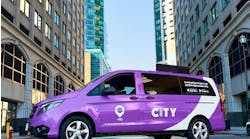Microtransit can deliver efficient service, reduce congestion and pollution and can improve connections to fixed route transit services, even when operated at a smaller scale, according to a new report by Boston Consulting Group’s think tank BCG Henderson Institute.
The report looked at four on-demand transit deployments by Via Transportation in Arlington, Texas, Seattle, Wash., West Sacramento, Calif., and Berlin, Germany. While Via provided information for the report, the company did not sponsor it. The locations, which all have on-demand services operated by Via, serve different mobility needs. In Arlington, the service fills a need where no fixed-route transit is available. In Berlin and West Sacramento, the service complements the existing public transit network and in Seattle, the on-demand service fills first and last mile gaps.
The report’s authors described the on-demand transit option as the “middle way” between the flexibility of a solo trip ride but without the contribution to congestion and pollution.
“There has to be a middle way – one that complements mass transit and allows cities to develop new travel options that reduce congestion and pollution and increase ridership,” the authors of the report write. “As mass transit adopts new technologies such as smartphone apps and cloud computing, that middle way is emerging.”
Highlights of what the report determined:
Arrival times: Berlin’s estimated time of arrival for an on-demand van was nine minutes – slightly faster than bus intervals at peak times on high volume routes. The estimated arrival time of an on-demand van in Arlington and West Sacramento was 12 minutes, which is longer than the three to six minutes arrival time of a ride-hailing service, but faster than the mass transit schedule.
Passengers per hour: The on-demand services studied average between 3.6 to 4.3 passengers per hour in each vehicle compared to 1.6 for private cars and vans and 1.9 for similar demand-response services in suburban and rural areas. The cities of study also produced improved numbers within peak travel periods where Arlington averaged seven passengers per hour, Berlin averaged nine and Seattle averaged 14. The report’s authors estimate that on-demand transit could help cities reduce traffic by 15-30 percent.
Farebox recovery ratio: The West Sacramento recovery ration was 20 percent; the national average for demand-response services is 7.5 percent and 19.2 percent for fixed-route urban bus routes.
Reduced congestion: In Arlington, the report says drivers were stuck in traffic an average of 45 hours per year. With the implementation of on-demand service, the city saw a 36 percent reduction in total vehicle miles traveled.
Reduced pollution: The West Sacramento and Arlington services operate using gas-powered vans, but the pooling of passengers resulted in an estimated annual savings in CO2 emissions of 60 tons in West Sacramento and 150 tons in Arlington.
The report also looked at on-demand service as a delivery vehicle of equality. The report pointed to the Seattle deployment where about 70 percent of trips to and from five light-rail stations are longer than one mile.
“First- and last-mile on-demand transit tackles this disparity head-on by expanding public transit options beyond walking distance from stations. The economic, employment and cultural centers of cities become accessible to remote regions,” the researchers said in the report.
The report concluded that there are three areas cities and transit authorities can explore to maximize the social and environmental benefits of an on-demand service. First, experiment to find the right application for a given environment. Next, integrate by folding on-demand transit into an existing mass transit network and create a seamless travel and payment experience. Finally, create “an ambitious regulatory framework with a mix of positive and negative incentives to encourage transit ridership.”
The authors say the report offers proof that on-demand transit can provide a way for cities to “take back their streets.”
“Our study showed that on-demand transit services work,” the authors write in the study. “In the right regulatory context, with lower per-passenger subsidies than those provided to comparable public services, these initiatives can benefit passengers and cities alike. Their convenience and flexibility improve the user experience over fixed-route mass transit while bringing good jobs within reach of neighborhoods poorly served by the status quo.”
The full report can be accessed here and Via also offered its take on the report through a blog.



